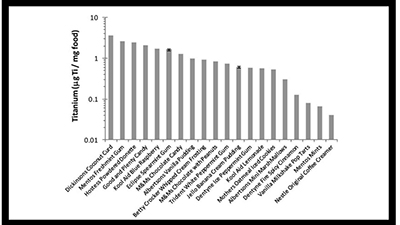| Titanium Dioxide Joins the Hit List to Manage Stress 10/11/18 |
In a previous blog post we put fluoride on the hit list to avoid consuming at all possible costs. You might wonder what substances like fluoride and titanium dioxide have to do with stress management. Remember, stress is anything that requires you to adapt or change—anything that takes you away from homeostasis. For the most part fluoride, titanium dioxide, and other substances like these usually do not impact you like being in an auto accident where the stress is immediate and eminent. These stressors slowly impact your health over time—decades. In addition to fluoride, we add one that you probably never heard of--it's a silent additive in lots of foods in your grocery store. In fact, as you read on, you'll see that this additive does not even have to be disclosed in the list of ingredients in many packaged foods. It's titanium dioxide. In general, we trust the FDA to keep our foods free from health endangering substances, right? So most of us would be surprised to discover that a mined, inorganic metal used in making steel, solar batteries, and paint products is common in every day food and cosmetic products like ice cream, frosting, white cakes, candies, ready to eat salads, sauces, sandwich spreads, skim milk and dairy products, cosmetics, sun block, shampoos and toothpastes. We might be slightly less surprised to know that the same metal is a substantial part of joint replacement parts, tooth implants and crowns. It is possible to be completely unaware that titanium is used in medical injections to target certain cancers, but all these are bits of TiO2 that are put into or applied to the human body daily. The metal is titanium dioxide or, as known in the food industry, E171. In 2017, approximately 1,100,000 metric tons of TiO2 (about 1% of all titanium used) were consumed in foods and body products in the USA, but most likely you never saw E171 on a food label. At this point you might be asking yourself why E171 is added to foods or body products. It turns out to be a serendipitous result. As women joined the liberation and the work force in the 1960’s and 70’s, fast foods, like TV dinners, takeout and store bought snacks replaced home cooked meals; unfortunately, such items didn’t look or smell all that appealing, so food manufacturers were looking for solutions. Level of TiO2 per mg of popular foods. Copy and enlarge to view. Foods to stay away from.
At the same time, titanium production and sales were leveling off and the titanium magnet DuPont tasked its research and development department to develop new markets. It turns out that one form of TiO2, anatase, when refined, has a high refractive index and a resistance to discoloration. It made a white substances look more opaque. These qualities, when applied, create a brighter, more appetizing appearance to white and brightly colored foods and body products. So, there we have it: a happy outcome for families, women’s liberation, medicine, beauty and mega wealthy mining moguls in one signing of FDA regulations and the profits are still increasing as we speak. The estimated sales for TiO2 (1% of total sales) are on track to record sales of $270.5 million in 2024. China is, as of 2010, the largest producer of titanium but the US still produces some and imports from Australia, Brazil and South Africa. A current affairs side note: the US imports titanium from Russia and is likely to use 80% of it in new military planes and weapons development. Now That You’ve Been Consuming Titanium since the 1960’s or whenever your birth allowed you to join the general munch down at the fast food/junk food bar and the beauty product aisle, you might like to know it's impact on your health. Is it safe to eat or put on your body? In 1966 the FDA adopted a rule that up to 1% of total food volume can be titanium dioxide without needing to be labeled on packaging and up to 10% in body products. They concluded this because titanium is maybe the most inert substance on earth (when it is found in nature) and since tests showed that it passed right through the digestive system causing no ill effects, there was no need to regulate it further. It was also deemed too large, size wise to penetrate the skin. Furthermore, although the size of the titanium particle is 200-300 nm, and nanometer sized particles have been cited in the news of late as problematic, the TDMA, manufacturers of TiO2 cheerfully assures us that 200-300 nm are too large to qualify as nanoparticles (100nm or less). Therefore, titanium dioxide is completely harmless and indeed without it, we would be at risk because all those modified foods would be very unpalatable without this colorant. Thus we would be at risk of finding them inedible and probably starve to death; we would totally risk skin cancer and rotting teeth without brightened sun block and brilliant toothpaste. The FDA ruling seems reasonable, right? The first research backing up the 1966 was presented in 1969 at the FAO/WHO* conference in Rome. Drawing from five published review studies, the body opined that there appeared no cancer or other negative effects of titanium dioxide in food or body products; thus it was safe at the 1% level for ingesting and at the 10-15% level body applications. This decision seems well supported, rationally based. However, a little known fact is that these rules were adopted in just one week at the Rome conference, by a single reviewer, based on five research studies in which one did not look at titanium but other metals, and in the four which were conducted on humans, rabbits, rats, mice and hamsters, inflammation onset was noted within five minutes of exposure to Ti02. Unfortunately, one of the body's main enemies, inflammation, was not a factor included in the criteria for review. This was done back in the dark ages of science. Several later studies in 1979 and again in 2010, looked at the connection between cancer and TiO2, but they were not definite in their findings. They were merely suggestive of a correlation. But Titanium Dioxide is Still Safe, Right? Returning once again to you and Ti02, research continuing over the years suggested that regularly ingesting small amounts of inert metal at the 200-300 nanometer size can be a serious problem. For one thing, it turns out that TiO2 erodes and about a third of a given amount become smaller than 100 nm, becoming “real” nanometer size. Furthermore, an adult weighing about 150 pounds absorbs at least 1mg/kg/day of TiO2 in a year; if you weigh 150 pounds, 150 mg x 365, that adds up to roughly 2 ounces of TiO2 gained a year. Children are even more at risk because the amounts of sweets and candy they consume. These absorbed Ti02 molecules are incorporated into amino acids and proteins in the body. These unsuspected and unlabeled dietary additives give the immune system indigestion and the various immune defenses inflame and attack as was noted in those early reviews studies (NLP3 inflammation is a key player here). Fact Is TiO2 is not safe? Yes, it can be very harmful in the brain, liver, lungs, spleen, pancreas, kidneys, colon and skin. If you are a sufferer of inflammatory colon disease or diabetes, chances are good that you are suffering in large part due to inflammation as a result of titanium absorption. Stay tuned for part II where we look at it's impact on allergies, diabetes, bowel disease and immune functioning. References: (1) Titanium Dioxide Nanoparticles in Food and PersonalCare Products (2) Color Additives: FDA's Regulatory Process and Historical Perspectives (3) Titanium dioxide nanoparticles: a review of current toxicological data | SpringerLink (4) (PDF) Critical Review of Public Health Regulations of Titanium Dioxide, a Human Food (5) Titanium allergy-MELISA (6) Titanium Dioxide Market Size Worth $28.5 Billion By 2025 | CAGR: 8.9% (7) TItanium Dioxide (TiO2) Market Size Worth USD 27.49 Billion By 2024: Hexa Research - MarketWatch (8) TItanium Oxide End Use (9) Food and Industrial Grade Titanium Dioxide Impacts Gut Microbiota| Environmental Engineering Science Waller,T., Chen, C., Walker, S.L. (10) TDMA (11) Re: What You Should Know about Titanium Dioxide | BestFoodFacts.org |
_______________________________________________________________________________
| Assertiveness & Self Confidence Builder CD $24.95 $19.95 |
Free Seven Part Report "Discover the Little Known Secrets--What makes Hypnosis Work" and Monthly Stress Management Tips℠ Bulletin
 |
Money Back Guarantee! |


